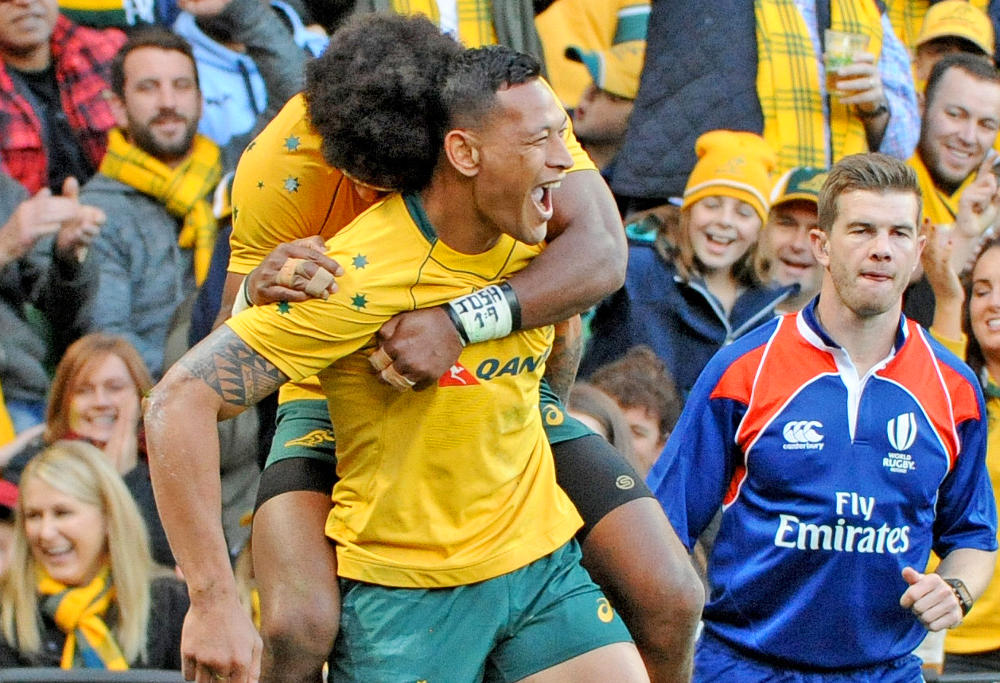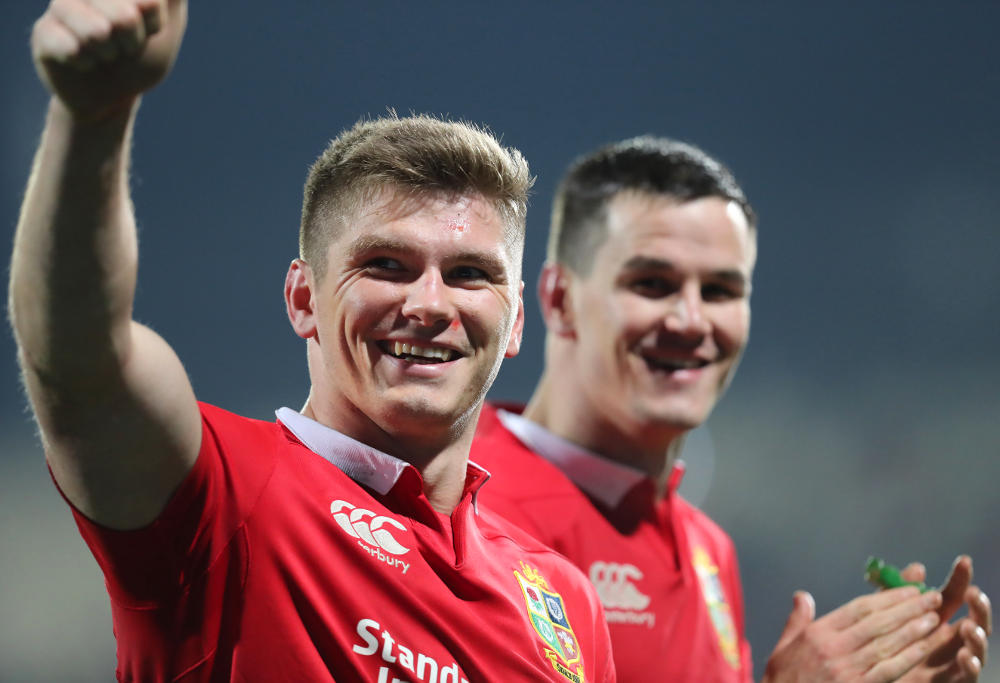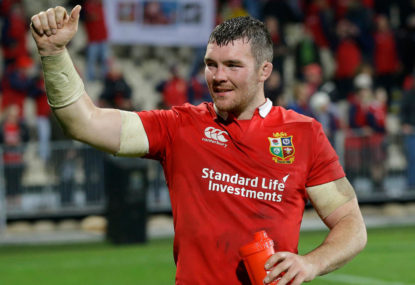This weekend provided a fascinating contrast between northern hemisphere and southern hemisphere rugby.
In sunny and dry conditions in Melbourne the Fijians, many of whom have come straight out of club rugby in France, failed to adapt to the pace of the Wallabies Super Rugby style of the game for the first 30 minutes and were shut out of the contest early.
Meanwhile, in damp, slippery conditions in Christchurch, the Crusaders failed to cope with the Lions notably non-Super Rugby style of game, where the kind of pressure and intensity that was applied to them seemed foreign, and ultimately proved too hot to handle.
It was a timely reminder that no matter how much the interchange of players, coaches and administrators around the world has resulted in a high degree of homogeneity in the way rugby players prepare and play, there remains more than one way to skin a cat.
While the Wallabies were fast out of the blocks – Israel Folau scored his first try after only four minutes – they struggled for much of the game to secure and retain possession and as a result often found the Fijians running the ball straight at them.
As an exercise in giving the defensive line a strong, early season workout it was mission accomplished, with Karmichael Hunt solid in midfield and flyhalf Bernard Foley twice taking down rampaging runners almost twice his size.
The stats sheet listed over 30 missed tackles, which on another day might be reason for concern, but Michael Cheika was right afterwards to place this in context, giving his side a pass mark for continually placing the Fijian ball carriers under pressure.
The Wallabies lineout wasn’t quite as fluid as expected, with one try coming from a rolling maul, but others disrupted by small handling and timing errors, which were nothing unusual for an opening Test match.
There was a strong performance up front, however, from lock Adam Coleman, going the whole 80 minutes and demonstrating once again his status as Australia’s premier lock forward.
On his return from France, halfback Will Genia was named man of the match in a game full of errors, standing out as much for his precision and consistent quality than anything else.

(Image: AAP Image/Joe Castro)
But if truth be told the standout player on the park – and by a considerable distance – was Fijian lock Leone Nakarawa. This Olympic gold medal-winning colossus was in everything, matching a high work-rate in defence with supreme running and off-loading ability and with still enough in reserve for a thrilling chip and chase at the end of the game.
Fiji’s set piece was solid throughout, and with some quality players to come back into the team this week they look set for a good June season ultimately aimed at securing their 2019 world cup qualifying position, likely to be in Pool D with Australia and Wales.
The embattled ARU has marketed this series of June internationals as ‘arvo Test rugby’, and while the walk-up crowd was only a modest 13,500, the benefits of a 3:05pm start were obvious.
At match end hundreds of children were allowed to swarm onto the ground and get close up with the Wallabies – a point not lost on captain Michael Hooper, who later spoke of how much the players enjoyed the experience and how it was a great initiative to show support for Melbourne rugby.
Long after the match had finished and the excited youngsters had been packed off home the Wallabies generously made available three players, one after the other, to talk about their experience. Notably all three put away the cliche book and were candid, although completely contrasting in their personality and reactions.
Israel Folau couldn’t stop smiling and spoke mostly about, well, being really happy to be running the ball from fullback and being able to smile about it. Karmichael Hunt was notably more serious, telling of his anxiety about playing his first Test in an unfamiliar role, reflecting on where life has taken him and how at age thirty he is savouring all of the good moments coming his way.
Ned Hannigan, sporting his Wallabies cap, was by contrast loud and animated, still buzzing with excitement and pinching himself at now being a Wallabies No. 6, just like so many famous players before him. He is far from the finished product, but that is something he is well aware of himself, noting that now that he has had a taste he is determined to put in the work required to establish himself as a Test player.

(Image: Martin Seras Lima)
While it might not have been sunny overhead in Christchurch, Warren Gatland and his side lit up their Lions tour, turning from zeros to heroes by doing what no other side has done this year: beating the Crusaders by 12-3.
More specifically what they managed to do was apply a Test match-like intensity to their defensive effort and maintain it for the whole game, not allowing the Crusaders to escape the clutches like the Highlanders and Reds did, for example.
This was an impressive showing from the Lions, bolstered by the inclusion of some first-choice players cementing their Test spots, not least the 8/9 axis of Toby Faletau and Conor Murray. Faletau has the experience of last year’s Wales tour of New Zealand to draw from, and on this showing the Lions are losing little from Billy Vunipola’s absence.
Certainly the Lions looked very compact and assured – not at all the side that came into the match under pressure compared to their unbeaten opposition – and unquestionably they were tactically superior on the night, which in itself provides a tasty dilemma for coach Gatland looking ahead to the first Test against the All Blacks in a fortnight’s time.
Last year Gatland’s Wales placed enormous pressure on the All Blacks in two of the Test matches by taking the initiative from them, playing positively with the ball and striking at all points around the park. As much as the All Blacks excel at this type of game themselves, they struggle when it is pushed straight back at them.
Ultimately Wales wasn’t able to sustain the intensity and skill level as Ireland was able to do in their famous Chicago victory, but prior to leaving the UK Gatland must surely have been thinking that with the ‘best of the best’ available to him he had 23 players capable of not only surprising the All Blacks but maintaining it over three matches.
This win against the Crusaders was not so much about adopting a more refined style but simply about getting the result and being able to leverage the confidence and good feeling that comes from that – and from getting the press off their backs. The whole squad will today have a spring to their step and a feeling that they can go on and be part of something special.

(Image: AAP IMAGE/Adam Binns)
But Gatland now has to decide if this style of rugby – winning rugby against the Crusaders – is enough to get the job done against the whole of New Zealand, who will have vastly more experienced players than the Crusader’s Richie Mounga and George Bridge, for example, who have been tearing it up in Super Rugby but who found this white-hot environment a bit too much at this early stage of their careers.
This was a result the tour badly needed. What the Lions do from here will be fascinating to see, but one thing the New Zealand rugby public now knows is that this is a side with character that hasn’t come all this way to hide behind a spin doctor and meekly accept an on-field flogging.
For whatever All Blacks coach Steve Hansen learnt from the Lions on Saturday night he also learnt plenty from the Chiefs 17-14 win against the Hurricanes in Friday night’s Super Rugby match in Wellington – that is if he was able to peel his hands away from his eyes, with every punishing contact a potential disaster on the All Black’s injury front.
As it turned out, the All Black squad members emerged largely unscathed except for the reputation of new centre Ngani Laumape, who was exposed as one-dimensional and absolutely schooled by the Chiefs’ Charlie Ngatai.
Indeed Ngatai, who is quickly recapturing the form he showed before his long enforced break from the game, and centres partner Anton Lienert-Brown were the dominant figures in a Chiefs performance which, in spite of the absence of Brodie Retallick, was more convincing than the scoreline suggests.
It was not the best of nights for Beauden Barrett either. He was uncharacteristically loose with his passing and too lateral in his direction of attack, which will not have escaped the attention of either Gatland nor Hansen.
Whether Hansen’s ability to remedy is superior to Gatland’s ability to exploit is another captivating question waiting to be resolved over the next few weeks.
Get in touch with a Daikin dealer today so you don’t sit and suffer through another cold winter while watching the rugby this year. Trusted by many and suitable for the Australian lifestyle, Daikin really is The Best Air Anywhere.
































































































